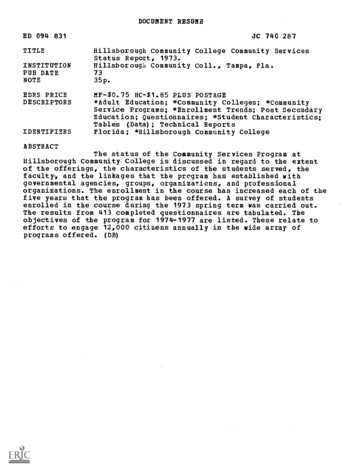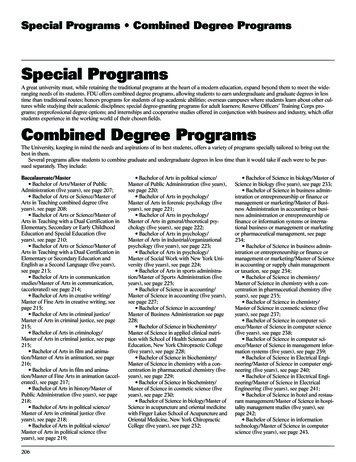
Transcription
CHARACTERISTICS OF COMMUNITY SERVICE PROGRAMSAND PROBATIONERS IN TEXASDarrin D. Roberts, A.A.S., B.A.Thesis Prepared for the Degree ofMASTER OF SCIENCEUNIVERSITY OF NORTH TEXASAugust 2002APPROVED:Gail A. Caputo, Committee ChairTory J. Caeti, Committee MemberEric J. Fritsch, Committee MemberRobert Taylor, Chair of the Department of Criminal JusticeDavid W. Hartman, Dean of the School of CommunityServiceC. Neal Tate, Dean of the Robert B. Toulouse School ofGraduate Studies
Roberts, Darrin D., Characteristics of community service programs andprobationers in Texas. Master of Science (Criminal Justice), August 2002, 52 pp., 5tables, references, 33 titles.As a criminal sanction, community service involves unpaid labor on the part ofconvicted criminal offenders. Community service was created as an alternative toincarceration for low-level offenders. It now appears, however, that community service israrely used as a true alternative to prison, but rather as an added condition of probation.The body of research on community service in the United States is modest, so relativelylittle is known about its characteristics and administration. Data were attained from 88Texas probation professionals via self-administered written surveys in an effort to gatherinformation about the use of community service as a criminal sanction in Texas.Frequency distribution analyses identified characteristics of both community serviceprograms and offender participants in Texas.
Copyright 2002byDarrin D. Robertsii
TABLE OF CONTENTSPageLIST OF TABLES . vChapter1. INTRODUCTION. 1Research QuestionsDocument Overview2. LITERATURE REVIEW. 4Community Service in EuropeCommunity Service in the United StatesAssociated Cost EffectivenessMajor Program EvaluationsOffender Perceptions of Community ServiceCriticisms of Community Service3. METHODOLOGY. 14Study GroupHuman SubjectsData CollectionThe PretestDescription of the QuestionnaireAdministration of the QuestionnaireData Analysis4. RESULTS. 255. DISCUSSION . 35Research Question ImplicationsRecommendations for the Future Structure and Success of CommunityServiceProject Limitations and Ideas for Further Researchiii
APPENDICES. 45REFERENCES. 47iv
LIST OF TABLESTablePage1. Characteristics of Respondents . 262. Characteristics of Departments . 283. Characteristics of Community Service. 294. Likelihood of Certain Offenders Being Ordered to Community Service . 325. Characteristics of Offenders with Community ServiceOrders during Fiscal Year 2000 . 33v
CHAPTER 1INTRODUCTIONCommunity service can be defined as a program that places convicted offendersin unpaid positions with non-profit or tax-supported agencies to work a specified numberof hours as a sentencing condition (Morris and Tonry 1990). Texas calls this conceptcommunity service restitution (CSR). Community service is an intermediate sanction.Intermediate sanctions are considered less punitive than prison, but more punitive thantraditional probation. Other sanctions grouped in this category include intensivesupervision probation (ISP), monetary penalties, home confinement, and boot camps(Wood and Grasmick 1999). Community service may be used as a stand-alone alternativeto incarceration, but is more commonly used as a probation condition or a penalty for aminor offense (Tonry 1997). Community service is one of the few sanctions that drawsupport from both liberals and conservatives. Liberals support community service due toits humane and rehabilitative nature. Conservatives support community service becauseof its potential to reduce prison costs and act as a more punitive alternative to probation(Perrier and Pink 1985).Community service is extremely flexible and can be tailored to match theseriousness of an offender’s crime. Although community service is popular with thepublic, benefits community improvement, and may ease prison overcrowding, it is theleast used of all intermediate sanctions (Tonry 1997). Research on intermediate sanctionshas often been dedicated to more controversial programs, such as boot camps and ISP.1
The body of community service research in the United States is not as large asthat in Europe (Tonry 1997). This lack of research has most likely contributed to itsinfrequent use as an alternative to prison. It can be argued that if more research wasdedicated to community service in the United States, it would become a more viablesentencing option. A better understanding of how community service is now administeredand what defines a successful program could possibly lead to future standardization.Standardization, in general, can be defined as comparing with a standard, or bringing intoconformity with a standard. This may involve identifying and studying exemplaryprograms as baselines for future standardization. Understanding how Texas’ largecriminal justice system is currently using community service for adult offenders is a stepin this direction.The foundation of this project is a survey examining community service for adultoffenders on probation in the state of Texas. A self-administered questionnaire was usedto gather data from criminal justice professionals on offenders who received this sanctionand the function and structure of community service programs throughout Texas.Research Questions1.What are the characteristics of community service programs in Texas?2.What are the characteristics of adult probationers who have been sentenced tocommunity service in Texas?By answering these two questions, this author hopes to gain a sharper view ofcommunity service in Texas. In other words, how does the average program administerthe community service sanction to the average adult probationer? This author believes the2
data obtained from this study is important because no such information previouslyexisted. The descriptive data presented here provides a previously unseen glimpse ofcommunity service as a sanction in Texas.Document OverviewChapter 2 of this document reviews literature on the history of community serviceresearch in the United States and abroad. Topics include its history as a criminal sanctionin the United States and Europe, major program evaluations, cost effectiveness,criticisms, and research gaps. Chapter 3 details the methodology used to gatherinformation for this project. This includes information on the study group, humansubjects, data collection, pretesting, questionnaire, and data analysis. Chapter 4 includesthe results of the descriptive data gathered from the study group. Chapter 5 contains adiscussion of relevant findings and implications from this research, recommendations forthe future structure of community service, project limitations, and ideas for furtherresearch.3
CHAPTER 2LITERATURE REVIEWThis chapter contains a review of relevant literature as it pertains to communityservice. The history of community service in Europe and the United States is examined,along with associated cost effectiveness, program evaluations, offender perceptions, andinherent advantages and disadvantages.Community Service in EuropeThe bulk of research on community service has been done in European andScandinavian countries, where community service is often used as a true alternative toprison, as opposed to the United States’ method of using it as a condition of probation(Tonry 1997). The origins of community service can be traced back to England’s use of“impressment,” which was the practice of forcing convicted offenders to supplement theranks of the Queen’s army in the 1600s (Pease and McWilliams 1980). Impressmentmarked the crude birth of community service as an alternative to prison.In 1973 the British government implemented the first program that introducedcommunity service on a nationwide scale. This was a strong endorsement for communityservice that encouraged English judges to use sanctions other than incarceration forserious offenders. Approximately eight percent of English offenders sentenced for seriouscrimes now perform community service (McDonald 1992). Even though England made aserious attempt to endorse community service orders on a national scale, it should not beconfused with standardization, as standardization involves configuring programs to meet4
a set of principles or guidelines. England simply encouraged the widespread use ofcommunity service without setting boundaries. England has been unable to equallyreconcile the main attributes of community service: punishment, reparation, andrehabilitation (Harding 1980). Different areas of the country give different weights toeach attribute, causing community service to be used differently in virtually everyjurisdiction. Due to this lack of equity in the administration of community service orders,it becomes a weaker sentencing option. Only with national standardization willcommunity service eventually become a solid and viable sentencing option in England(Harding 1980). The United States currently shares many of these same struggles.The Netherlands has also adopted community service with some success. Thenumber of community service orders has increased from 213 in 1981 to 12,737 in 1995.By 1989, community service had become the third most often-used penalty in theNetherlands (Spaans 1998). As in many nations, however, community service is notalways used as the alternative to short-term incarceration it was promised to be. Instead,community service is often imposed as an alternative to other non-incarcerativesanctions. Thus, community service in the Netherlands has not made a dramatic impacton reducing imprisonment.Scotland, too, has found community service to be a fine addition to its sentencingrepertoire. Less costly than prison, it was effectively applied across a varied range ofoffenders with high completion rates (McIvor 1993). The only negative aspect of itssuccess was that judges were so fond of the burdensome sanction that they ordered it forrelatively minor offenses that could have been handled with a lesser sanction, such as a5
fine. This concept is known as “net-widening.” In theory, net-widening in communityservice takes place when low-risk offenders (who would normally receive traditionalprobation) are sentenced to community service. Subsequently, since community serviceorders often have more stringent supervision rules than traditional probation, the numberof technical violations increase, thusly leading to more offenders being incarcerated inthe long run (Gendreau, Goggin, Cullen, and Andrews 2000).Not all nations are quick to adopt change, however. Denmark introducedcommunity service as an experiment in 1982, but took 10 years to finally make it apermanent part of the Danish Penal Code (Lutz 1993). Likewise, Finland encounteredsentencing bias while implementing community service as an alternative sanction (Takala1993). Some groups of offenders were being dealt more serious punishment than othersfor similar crimes. The major concern was how to order certain offenders to communityservice while retaining the concept of fair and equitable punishment for equal crimes. Arelaxation of suitability requirements was undertaken to promote equity - even thoughthere was a risk that a higher percentage of offenders would ultimately fail to complywith the order (Takala 1993).Currently, a diverse array of nations, such as England, Wales, Scotland, Germany,Finland, Denmark, the Netherlands, and Australia use community service as analternative to prison in varying degrees (Bray 1990; Lutz 1993; McGivor 1990; Pease andMcWilliams 1980; Schneider 2001; Spaans 1998; Takala 1993). Even developing nationssuch as Zimbabwe, Uganda, and the Central African Republic have began usingcommunity service as an alternative to prison (Stern 1999).6
Community Service in the United StatesCommunity service in the United States can be traced back to the late 1960s andearly 1970s. Judges in California’s Alameda County were tired of imposing fines onfinancially destitute women for traffic offenses and subsequently jailing them when theycould not pay the fine. As an alternative, the women were ordered to work without pay onproject sites that would benefit the public (McDonald 1992).By the late 1970s, the Law Enforcement Assistance Administration (LEAA)began funding a limited number of community service programs in the United States.These programs were intended to be an alternative to traditional sanctions, such as jail,fines, and probation (Cooper and West 1981). Between 1978 and 1981, the LEAAdonated 30 million dollars to establish programs in 85 jurisdictions (Krajick 1982).Unfortunately, when LEAA funds ran out, over half of the programs ceased operations.Associated Cost EffectivenessThere is evidence that shows community service may be more cost-effective thanan array of other sanctions, both alternative and traditional. In 1978, a cost analysis wasperformed comparing community service programs with a number of other sanctions.The average cost for a probationer’s year in a community service program in a primarilyrural county was 589.68. In contrast, a year in a halfway house would cost 6,649 and ayear in a state institution would cost 9,215. Also, drug treatment programs ranged from 1,728 to 6,254 per year for each client (Thalheimer 1978). Results such as these havebeen repeated to varying degrees in community service programs throughout the UnitedStates.7
Suffolk County, NY undertook a community service program in 1984 that wasdesigned to ease jail overcrowding and provide a cost-effective alternative to jail.Although Suffolk County’s jail population increased somewhat, an estimated 4,199 to4,461 jail days were spared over a 27 month period. Also, the program reputedly returned 230,828 to the county through saved jail costs and community service performed in thecommunities (Brownstein, Jacobs, and Manti 1984).In Virginia, an evaluation was performed on community service programssupervised by New River Community Sentencing, Inc. (NRCS). In Fiscal Year (FY)1987, the total value of the program was 180,754. This amount included the value ofwork performed in the communities ( 115, 014), savings on probationer supervision overtraditional probation ( 15, 408), saved jail expenses ( 13,800), and wages earned by theprobationers ( 36,532) (DCJS Evaluation of New River Community Sentencing 1988).More recently, Connecticut’s alternative sanctions program, which highlightscommunity service, has been shown to be a cost-effective alternative to traditionalincarceration. Since 1990, over 40,000 offenders, many of whom would have been sent toprison for the first time, have been placed in the alternative sanctions program. In 1998,the program provided services to over 4,500 adult offenders (Coleman, Felton-Green, andOliver 1998). The Connecticut Office of Alternative Sanctions (OAS) provides anencouraging cost analysis. One year in the alternative sanctions program costs 7,000 foreach slot (with an average of four clients in each slot throughout the year), whiletraditional incarceration in Connecticut would cost nearly 25,000 per year for each8
offender (Coleman et al. 1998). The OAS claims the program has saved a projected 619million in capital and operating costs since its inception in 1990 (Coleman et al. 1998).During FY 1998, 148,058 offenders participated in community service programsin Texas, donating a total of 6,004,335 hours. Combining those hours with the (1998)minimum wage of 5.15 shows that 30,922,325 in labor was donated to the participatingcommunities through community service. Using the same method of calculation, FY1999 yielded 43,709,847 in free services to the community from 211,960 offenders(Community Service Restitution and Victim Restitution Report 2000).Not everyone, however, is totally convinced that community service programssave a considerable amount of money over incarceration. Some charge that communityservice programs make inflated claims of cost effectiveness that do not take real costsinto account. Critics claim that most cost analyses have used average daily costs insteadof more suitable marginal costs in their savings formula. Also, many entirely ignorecapital spending issues (Parent, Dunworth, McDonald, and Rhodes 1997). Under thesestrict analyses, community service programs may show little, if any, savings overincarceration. In light of these criticisms, community service advocates are quick to pointout that many of the cost-effective benefits of community service may be intangible andoblique (Cooper and West 1981). How does one put a price on an offender gaining selfesteem through community participation? Vague definitions of success are one the pastEuropean problems the United States is just now encountering.9
Major Program EvaluationsThe first major research on community service in the United States involved anevaluation of the Community Service Sentencing Project (CSSP) conducted by DouglasMcDonald in 1984 (McDonald 1986). The program operated in Manhattan, Brooklyn,and the Bronx. The CSSP was designed to punish minor offenders who would normallyreceive a fine, and as an alternative penalty for middle-level offenders who would usuallybe sent to jail. Offenders worked in low-income neighborhoods for 10 days (70 hours)without being paid. The offenders were supervised by Vera Institute of Justice staffmembers (Vera initiated the program and evaluated it via McDonald). Overall,McDonald found CSSP to be a success and recommended its continuation.McDonald’s research was designed to answer three questions: First, wascommunity service being used in place of jail sentences? McDonald found that it wasindeed diverting offenders from jail, but not in all the boroughs where it was operating .Second, did the CSSP decrease recidivism? In this case, re-arrest information examinedsix months after release from the program showed that 43% had been re-arrested for anon-violent offense. However, that was comparable to a group that had been eligible forCSSP, but received a jail term. This furthered the idea that community serviceparticipants were no more likely to re-offend than those sent to jail.And finally, what were the main benefits of the program? McDonald foundcommunity service was good for the community. He estimated that 60,000 hours of10
service had been completed in the community in 1984. Taking into account the minimumwage in 1984, the community gained approximately 270,300 in free labor (McDonald1986).As it happens, the only other major evaluation of a community service program inthe United States was also a Vera Institute of Justice study of CSSP (Caputo 1999;Caputo, Young, and Porter 1998). Since McDonald’s findings in 1984, CSSP operationswere transferred from the Vera Institute to the Center for Alternative Sentencing andEmployment Services (CASES). The program had also slightly changed; it was nowspecifically designed to divert offenders from jail sentences of up to six months. Therevamped program put them to work for either 70 or 105 hours, depending on their levelof offense.The new study mainly focused on the program, staff, and experiences of a cohortof offenders who participated in the program between December 1997 and February1998. The research team explored completion and failure rates, reasons for termination,and attendance and compliance efforts, among many other variables. Overall, positivefindings were discovered. Mainly, program completion rates were the same or higherthan in the past (74%) and were higher than the program’s contract required. Of all theparticipants who failed, all but three were rule related; the CSSP initiates court action incases of non-compliance. Essentially, this action by the program showed that the sanctionhad “teeth” to it if violated. Also, this study pointed out that these programs can besuccessful with low-level recidivists.11
Offender Perceptions of Community ServiceRecent research supports the assumption that community service is not a “walk”for offenders. Although the general public may believe some alternative sanctions are notharsh enough, the offenders do not always share that opinion. Many repeat offendershave had experience both with prison and a variety of sanctions. The research impliesthat many offenders would rather go to prison for short periods of time than endurelonger periods of intermediate sanctions (Wood and Grasmick 1999). The inmates werecomfortable in the confines of prison; in comparison, various intermediate sanctions(including community service) were deemed to be too burdensome to endure. This speaksvolumes to the effectiveness of alternatives to incarceration, such as community service.Criticisms of Community ServiceThere have been some suggested disadvantages of community service, however.Judges were often reluctant to order community service since the sentence may not beproperly carried out (Meyer and Jesilow 1993). According to judges, their goal was to“do justice.” If offenders did not complete the sentence or were unsupervised, justice hadnot been served for society or the offender. If judges do not have confidence incommunity service, they will choose other sanctioning options.Like Finland, the United States has also faced sentencing bias in communityservice orders. California judges were sentencing minorities to less desirable workassignments (such as picking up trash along freeways) than whites (Meeker, Jesilow, andAranda 1992). Since work placement was a matter of judicial discretion, researchers12
considered it biased. Matters that dealt with legal variables, such as number of hourssentenced and offense coding, were not affected by judicial bias (Meeker et al. 1992).Unfortunately, there is no national reporting system that details the number ortype of community service programs, what type of agencies run them, and whichoffenders are ordered to complete community service. In fact, it is difficult to knowexactly how many offenders perform community service in the United States (McDonald1992).Due to the modest body of research, there is little in the way of a definition of asuccessful community service program; thus, standardization is virtually nonexistent inthe United States. This is most likely why community service is still the least-usedintermediate sanction (Tonry 1997). This research project attempts to fill some smallgaps in this literature by reporting on the characteristics of community service in Texas.13
CHAPTER 3METHODOLOGYThis section contains an overview of the methodology used to obtain data fromthe respondents. Topics include the study group, human subjects, data collection,pretesting, questionnaire description, administration of the questionnaire, and dataanalysis.Study GroupThe research is focused strictly on community service sentencing for adultoffenders in Texas. Since, as the literature suggests, community service is most oftenused as a condition of probation supervision, and therefore administered by probationdepartments (see Tonry 1996), the best source of information about community service inTexas would be the personnel of adult probation departments. Therefore, the target studygroup for this research was composed of personnel from all 122 adult probationdepartments (referred to as Community Supervision and Corrections Departments, orCSCDs).A directory of the 122 Texas CSCDs was obtained from the Texas Department ofCriminal Justice website (www.tdcj.state.tx.us/cjad/cjad-phones.htm). The directory listsCSCDs by county, and includes phone numbers, fax numbers, cities, and zip codes. Nostreet addresses or contact names were listed. Although Texas is composed of 254counties, there are 122 CSCDs. A number of CSCDs serve more than one county(operating as regional CSCDs), presumably to account for small citizen populations in14
some counties. Being that all 122 Texas CSCDs are included, this research project istechnically a census survey. The term census refers to gathering information about everyindividual in a given population (Fowler 1993).The target study group included individuals from each CSCD expected to be mostknowledgeable about community service in that jurisdiction. One hundred twenty-twoindividuals were identified as potential respondents.Instead of sending the survey to each CSCD Director (or individual “in charge”)and hoping it would find its way to the individual most knowledgeable about communityservice in that CSCD, a different method was used in effort to increase the response rateand ensure the “correct” individual would complete the survey. A description of themethod used to determine who was most knowledgeable about community service issupplied below.First, each individual most knowledgeable about their CSCD’s community serviceprogram was identified and contacted by telephone. With contact information located onthe Texas Department of Criminal Justice website (www.tdcj.state.tx.us/cjad.htm), atelephone call was made to each CSCD. The person answering the telephone call usuallydepended on the size of the CSCD; larger CSCDs often used administrative officepersonnel and voicemail systems, while probation officers answered in smaller CSCDs.Once connected, I introduced myself, told the individual I was part of a researchteam at the University of North Texas that was conducting a survey of community servicein Texas, verified the mailing address, and was provided the name of the individual incharge of that CSCD’s community service program. The individual who answered the15
phone was simply asked if they knew who was in charge of their community serviceprogram. If the CSCD did not have a formal community service unit, the individual wasasked to provide the name of the person who was most knowledgeable about communityservice in that CSCD.After having confirmed the name and title of the individual most knowledgeableabout community service, when possible, the individual was immediately contacted bytelephone. Then, I introduced myself, explained the research project (and the fact that itwas reviewed and approved by the University of North Texas Institutional ReviewBoard), including its goals, data collection method, what would be expected of eachrespondent and that he or she had been selected to participate, and informed theindividual that he or she would receive the survey via mail in two weeks.Not every respondent could be immediately contacted because he or she wasunavailable. In these cases, a message was left for the respondent.Overall, of 122 potential respondents, this author spoke with 68 individuals(56%), left voicemail messages for 24 individuals (20%), and left messages with officepersonnel or other probation officers for 30 individuals (24%). Among the original targetstudy group, 88 subjects returned a survey and constitute the study group. This isdiscussed in a following section.Human SubjectsThe project complies with the University of North Texas policy on the use ofhuman subjects. Prior to the commencement of the project, the principal investigator, Dr.Gail Caputo, submitted an application for Institutional Review Board review (application16
number 241). The project was reviewed and approved by the University of North TexasInstitutional Review Board on November 30, 2001.The only plausible and foreseeable risk to human subjects involved in the projectwould be the potential release of confidential information. Common data securityprocedures were used, including the removal of all personal identifiers fromquestionnaires, and storing of completed questionnaires in a locked file cabinet accessibleonly to the research team. A numeric code is used to match the questionnaires to therespondents.Ensuring voluntary participation in the survey process is an ethical cornerstone ofresearch involving human subjects. Respondents need to be completely informed aboutthe project for which they are volunteering (Fowler 1993). Informed consent in thisproject was gained through two avenues: the cover letter sent with the mailing packet andthe first page of the survey. Both include a brief description of the survey’s purpose, theorganization funding and carrying out the research, a description of confidentialityprocedures, assurance that participation is completely voluntary, research team contactinformation, and directions for completion of the survey questionnaire.Data CollectionThe data collection method used in this research was a self-administered writtenquestionnaire delivered by mail. The method was chosen above others for severalreasons: it was less expensive and time intensive than other methods, the number ofproject staff was limited, and it allowed respondents the time necessary to look upanswers needed for statistical questions. Also, it was expected that respondents would be17
accustomed to completing surveys and he or she would be competent and capable enoughto complete the questionnair
Community service can be defined as a program that places convicted offenders in unpaid positions with non-profit or tax-supported agencies to work a specified number of hours as a sentencing condition (Morris and Tonry 1990). Texas calls this concept community service restitution (CSR). Community service is an intermediate sanction.










